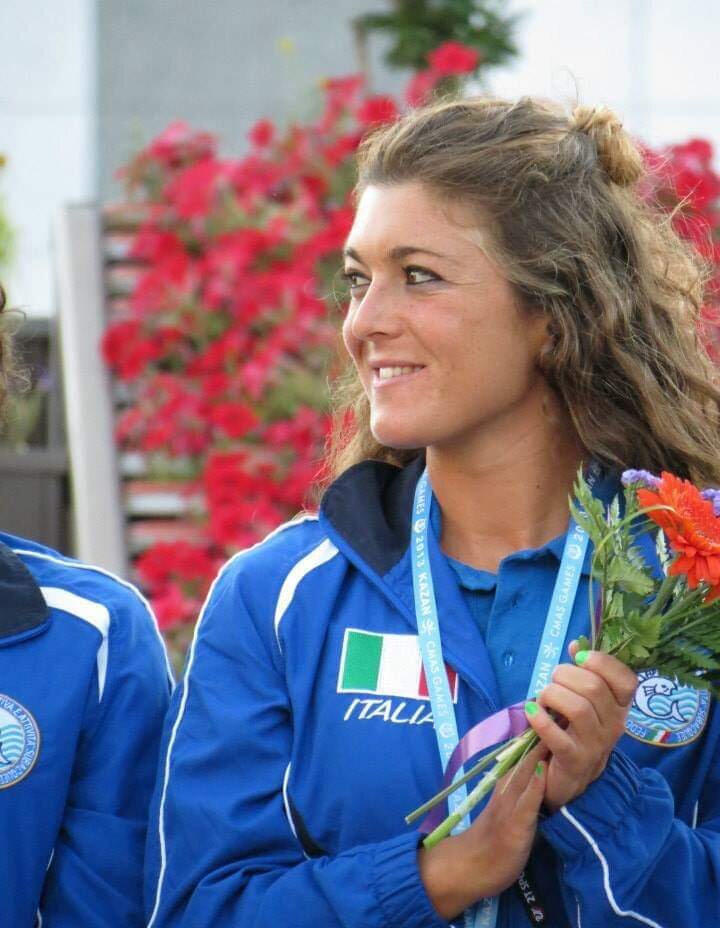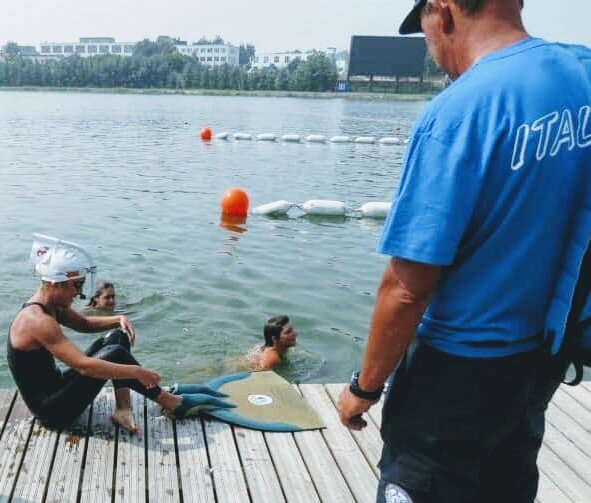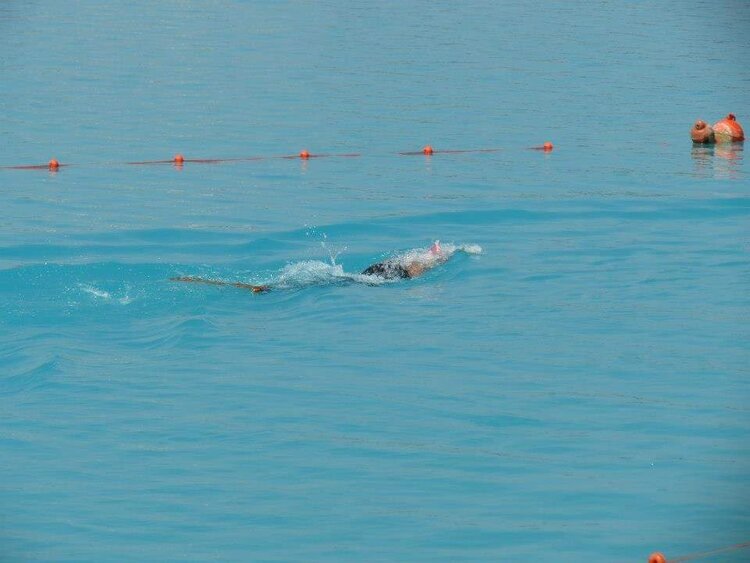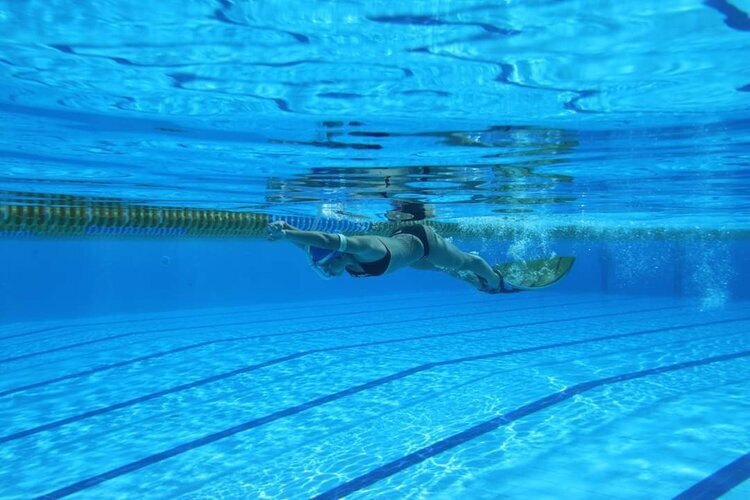Sara Turrini - Sydney, Australia
Swimming is ‘a school of life’. Sometimes it’s tough love, but that’s where the real lessons are.
Swimming is my physical and mental addiction . . . I crave it.
Through three years of sickness, but with a steely determination to continue to swim, Sara was introduced to a new aquatic activity to help her stay involved in the sport she loved.
“My swimming went downhill, but I never stopped. I needed something to keep my mind away from my disappointing performance. My coaches introduced me to finswimming. With new techniques to learn, different equipment to try, different types of training to become involved in, I was able to refocus, recover and restart my swimming career, as a finswimmer.”
Sara went on to represent Italy at numerous international finswimming championships. Her story starts in Tuscany, Italy, where the four year old Sara was learning to swim with her mother, and three years later at the age of seven, with coach Alessandra, “the most positive, and loudest lady I have ever met.”
Don’t rescue me, rescue my boat!
“I wasn’t an attentive learn to swim student. My mother tried to each me the basic survival skills but I was more interested in water play. I must have learned something because they were put to good use when I fell out of my grandparent’s boat.”
Sara’s grandparents lived on a boat in the Mediterranean Sea off the coast of Tuscany during the warm Italian summer months. The boat was big enough to accommodate the growing family, young Sara and her parents would join them at every opportunity, making the most of the beautiful surroundings and the proximity to the water.
“I was about four years old. It was early in the morning and as usual I was skipping around the boat’s deck happy to be in such an amazing place. I remember I was still in my pyjamas but wearing a pair of shoes. Half ready for the day, I guess! I was asked, more than once, to stop skipping as it was too dangerous on a boat. Too late! I fell overboard, holding a toy boat I had with me. Fortunately I didn’t panic; I was floating! But my boat was sinking. When the family jumped in to rescue me I was upset! Couldn’t they see I was fine, floating in the water? And why weren’t they trying to rescue my sinking toy boat?
“After that incident it was clear I had to learn to swim properly, so I attentively listened to my mum and became more competent in the water. So much so I was able to make the most of the beautiful Tuscany coastline and it’s many islands; I was always in the sea, often side tracked as I swam after schools of fish.”
Early competition, later maturity
Sara started competitive swimming as a seven year old, training three time a week. “Honestly, I didn’t like the training part, but I did like the whole experience that came with it. So I stuck at it.”
Sara reckons she was a typical child in the pool, not easy to coach when she did not want to train. “I hid under the lane ropes. I really didn’t want to swim laps.”
Despite her obvious talent, Sara’s parents didn’t push the young swimmer; “I was lucky. My parents never pushed me and I think that’s what kept me going. I didn’t burn out at a young age, which happened to some of my team mates. I didn’t enjoy training but I was naturally a strong swimmer, and had developed good technique.” It stood her in good stead. Sara spent the next 24 years competing in more than one aquatic sport discipline.
“When I started to compete seriously my whole life was a bricolage of training and competition, university study and having a social life. It worked for me and I never had a problem with prioritising one over the other. My parents gave me so much support and help. I’ll never thank them enough.”
Successes and disappointments
“My best swimming memories are also my worst. But I think that’s part of the game. You fall, you stand up and you keep going.
“When I was 14 and 15 years old I was winning regional competitions in Italy, and I was qualifying for Italian nationals. I was in a good space with nothing too excessive – my results were better than my investment in training indicated. But then I started to feel sick and it took three years to get a proper diagnosis of being celiac. They were the worst three years of my life. I was so sick and weak. I struggled with everything. My swimming went downhill, but I never stopped. That’s when my coaches introduced me to finswimming – to help me keep doing the sport I loved without the disappointment and frustrations of trying to manage a traditional competitive swimming regime.”
International finswimmer
A single fin, the monofin, or with two fins, bifins, are the equipment choices which make up the core characteristics of finswimming. It is a specialist swimming sport. There are four defined disciplines each having different distances and equipment, held in both pools and open water, either on the surface or underwater.
As Sara ventured into this new aquatic world, she initially focused on the bifin class. In this discipline the swimmer wears a front snorkel and two fins, swimming freestyle. Her initial bifin events were varied, from short pool sprints of 50, 100 and 200m to 3000m in open water. Training picked up as her strength grew and for the next 5-6 years Sara developed the skills and techniques to compete at international level, moving from bifin to monofin.
“Monofin is different to bifin” Sara explains, “it’s a single fin in which both feet are placed. The leg movement is restricted to dolphin kick. The body is streamlined and the arms are extended frontwards, with hands together, locking the head between to biceps ensuring the upper body glides without moving up and down. It’s a strong undulating movement from the core and hips through to straight legs, keeping the knees locked. You still wear a front snorkel and swim on the surface.
“My best results were definitely in the last five years of my competitive career, which ended in 2015.
“One very special moment was when I qualified for the Italian National Team. I’ll never forget that day. It was a glorious moment for me.” While her early illness was devastating, Sara’s resilience introduced her to new aquatic pathways and opportunities to excel. “It felt amazing to be back in the game again. I came through. I made it!
“Every step after that is etched in my memory, winning Italian, European Championships and World Cup events. I was placed third at the European Championships in 2010 in Russia in the individual 6km event, and in 2012 in my home country of Italy the 20km race, and third place with my team in the 4x3km relay. At the World Championships I was fourth in 2011 in Hungary, in both the 20km individual and 4x3km relay. In the 2013 World Champs, back in Russia, I was part of the 4x3km relay team which was placed third. I recall every single race as if it happened yesterday.”
Sara moved to Sydney in 2010. Swimming for her native Italy and training in Australia added to her new challenges. “I trained 14-16kms a day by myself. I had to find pools and more extensive water in which to clock up the mileage. I used to swim in Manly Dam whenever I could.”
Sara tried to set up a finswimming squad to have people to train with as well as introduce more people to the sport. A niche sport and the sprawling Sydney suburbia was too challenging, so she continued to train solo, always mindful of her world stage end goal.”
Sara’s intensive monofin period was abruptly ended when a related injury forced early retirement. “I was predisposed to foot injuries, exacerbated by the hours swimming with a monofin. I ended up having surgery on my feet, the recovery requiring time in a wheelchair, then a moon-boot and then rehab. It was time to hang up my goggles and fin. But I’ll always be thankful for the opportunities they gave me.”
Swimming today
Sara is back in the water now, and swims five or six times a week, for pleasure rather than competition. “It’s been hard to go from revolving my life around training and competitions to enjoying a swim without looking at the clock all the time. But I’m getting there.”
She still prefers distance training over sprint sets but sees the advantage of short and intensive activity these days.
“Even though I occasionally swim solo, I prefer to train with a buddy. I sometimes swim with squads because I like the social aspects, and I find I push myself more without even realising it. Being coached also helps with technique and stroke correction.”
Sara swims in her local pools and seas around Manly, Sydney. The Manly Aquatic Centre as well as in the ocean at Manly and Freshwater.
Special places to swim
Sara recommends many places along the west Italian island dotted coastline of Tuscany, especially the islands of Elba and Capraia and further south at Porto Santo Stefano, Porto Ercole, Argentario
In Spain’s Balearic Islands swim in the amazing crystal clear waters of Palma de Mallorca
Animal rescue and senior lifeguard
Sara’s non swimming life is surrounded by animals. “I have a large family of rescue animals. I volunteered for Sydney Dogs and Cats Home and have been a volunteer at Sydney’s Taronga Zoo Wildlife Hospital once a fortnight for the past two years. I studied Marine Biology in Italy, studied vet nursing in Australia and have a Cert III in Captive Animals.” But swimming is still the backbone of her professional existence. As a Senior Lifeguard for Sydney’s Northern Beaches Council, Sara continues to find herself in familiar surroundings, although out of the water most of the time.
A final word or three
Don’t push your children too hard (to compete in swimming). If the passion is there, they will find their way at the right time.”
“Swimming is ‘a school of life’. Sometimes it’s tough love, but that’s where the real lessons are.”
“It doesn’t matter if you are preparing for the Olympic Games, the local competition or just to burn calories, enjoy it! That’s the most important part.”






